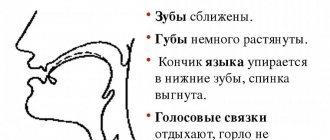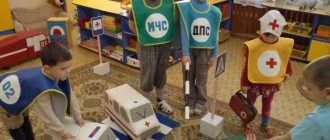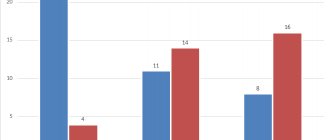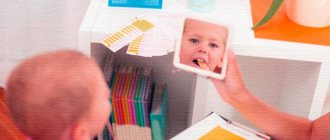Examination of the sound pronunciation of preschool children (G.V. Chirkina)
An educational and methodological set of diagnostic techniques for examining the sound pronunciation of preschool children was created on the basis of a modern approach to diagnosing the mental development of preschool children. It provides detailed explanations for filling out the main sections of the children’s speech development questionnaire and suggests examination techniques available to the child.
The materials in this section will be useful not only to students of pedagogical educational institutions, they will be useful to a wide range of specialists in preschool educational institutions (educators, speech therapists, speech pathologists), as well as parents striving for the comprehensive development of their children.
Purpose: study and observation of the sound side of speech of preschool children.
SURVEY OF SOUND PRONUNCIATION IN PRESCHOOL CHILDREN
Examination of speech sounds in children begins with a thorough examination of isolated pronunciation. Then they examine the sounds in words and sentences.
The following groups of sounds are checked: vowels: A, O, U, E, I, Y; whistling, hissing, affricates: S, Sь, 3, Зь, Ц, Ш, Ш, Шch; sonorous: P, Pb, L, L, M, Mb, H, Нь; unvoiced and voiced paired P-B, T-D, K-G, F-V - in hard and soft sound: P'-B', T'-D', K'-G', F'-V'; soft sounds combined with different vowels, e.g. PI, PYA, PE, PYU (also DY, M, T, S).
During the examination, it is necessary to note the nature of the child’s pronunciation of isolated sounds, indicating the nature of the violation (for example, the sound S is interdental: the sound Ш is replaced by the interdental S; the sound Ch is replaced by Тъ, etc.).
They use tasks that consist of repeated repetition of one sound, because in this case, conditions are created that facilitate articulatory switching from one sound to another. This makes it possible to detect difficulties in the innervation of the articulatory act, especially in cases of “erased” dysarthria. Repeating two sounds or syllables separately, which involves a clear articulatory switch (for example, KAP-PAK), is also useful for speech therapy analysis. First, sounds that differ sharply from each other in articulation are presented, then sounds that are closer. At the same time, there are cases when children do not succeed in motor switching from one sound to another and, instead of repeating the initial sound of the second pair, they perseverate the previous one. The appearance of “average” articulation is also noted (for example, T and D are transmitted by the same semi-voiced ones, T and T' - semi-soft).
The speech therapist then finds out how the child uses sounds in speech. When checking, attention is paid to substitutions, distortions, and omissions of sounds. For this purpose, the pronunciation of words is examined. Sets of pictures are presented, including words from the sounds being tested; words of different syllabic structures are selected.
The pronunciation of hissing and whistling sounds can be found in the example of the words dog, wheel, nose, pine, shepherd, cash register, hat, fur coat. Particular attention is paid to how these sounds are pronounced in sentences. For example:
The cat has a fluffy tail. Sasha gave way to the old woman. The bear cub climbed a pine tree. The hen has five fluffy chicks. Birds are chirping in the thicket. And etc.
The pronunciation of sonorant sounds Р, Рь, Л, Ль, М, Mb, H, Нь is studied in isolation, as well as in syllables and words (desk, boat, plate, rabbit, briefcase, propeller, painter, rails, piano, wings, etc. ).
Suggestions for repetition:
The couple broke the plate. A painter is painting a stall. The ship is decorated with flags. The eagle is on the mountain, the feather is on the eagle.
When examining the pronunciation of voiced and voiceless consonants (P-B, T-D, K-G, F-V, S-3), it must be taken into account that the degree of deafening of consonants by children may not always manifest themselves to the same extent. Words for repetition: squirrel, carriage, cubes, paper, bell, teddy bear.
Suggestions for repetition:
A squirrel is jumping on an oak tree. The children saw a woodpecker's hollow in the forest. Zina's teeth hurt. Sonya ties a blue bow. The snake hisses and the beetle buzzes. And etc.
The pronunciation of soft and hard consonants is examined using the example of their combinations with the vowels I, Ya, E, Yo in the words: children, kitten, glass, linen, five.
Suggestions for repetition:
The cat has five kittens. Guys love raisins. Aunt Nyura made cranberry jelly. And etc.
With the help of special tasks, the ability to switch articulatory movements is revealed. The child is usually asked to repeat a sound or syllable series several times, and then the sequence of sounds or syllables changes. It is noted whether switching is easy.
A-I-U, U-I-A, etc.; KA-PA-TA, PA-TA-KA, TA-PA-KA; PLA-PLU-PLO, PLO-PLU-PLA, etc.; Drip-pack-drip-pack... RAL-LAR-RAL-LAR...
The ability to pronounce syllables with multiple consonants is also tested SKLA, VZMA, ZDRA, etc.
To examine a child’s ability to pronounce words of varying syllabic complexity, he is presented with object pictures, to which he gives a name; then the same names are proposed for reflected pronunciation. The results of both types of tasks are compared and it is noted which is easier for the child to complete. It is also important to note whether the words whose syllabic structure is distorted consist of learned or unlearned sounds. The nature of the distortion is noted: reduction in the number of syllables: matok instead of hammer, simplification of syllables: tul instead of chair, likening syllables: tattoo instead of stool, adding the number of syllables: komanamata instead of room, rearrangement of syllables and sounds: devereux instead of tree.
You should check the ability to pronounce sounds in sentences consisting of correctly pronounced sounds and defective ones.
To identify minor violations of the syllabic structure of words, the child is presented for repetition with sentences consisting of words of increased sound-syllable complexity: Petya drinks bitter medicine. A policeman is standing at the intersection. An astronaut controls a spaceship. And etc.
The identified sound defects are grouped according to phonetic classification.
Examination of the structure and functions of the articulatory apparatus is important for determining the possible causes of disturbances in the sound aspect of a child’s speech and planning corrective exercises. During the examination, it is necessary to assess the degree and quality of violations of the motor functions of the organs of articulation and identify the level of available movements.
Literature.
Methods for examining children's speech: A manual for the diagnosis of speech disorders / edited by. ed. G.V. Chirkina. – M.: ARKTI, 2003. – 240 p.
“Help on the site” - click on the image - hyperlink to return to the previous page - “DIAGNOSTIC TECHNIQUES FOR EXAMINING DIFFERENT ASPECTS OF SPEECH IN PRESCHOOL CHILDREN” .
Examination of the state of sound pronunciation in children
It is very important to promptly and completely examine the speech of a child with pronunciation problems. By timely detection of speech pathology, we mean a speech therapy examination, which is carried out no later than 4 years of age.
When performing a speech therapy examination of children with dyslalia, it is necessary first of all to study in detail the structure and mobility of the organs of the articulatory apparatus. Then carefully examine the state of sound pronunciation. In addition, it is important to find out the state of sound pronunciation. In addition, it is important to determine the state of phonemic awareness. Let us dwell on each type of speech therapy examination separately.
An examination of the articulatory apparatus begins with checking the structure of all its organs: lips, tongue, teeth, jaws, palate. At the same time, the speech therapist notes whether there are any defects in their structure, whether it corresponds to the norm.
During the examination, the following anomalies can be detected in the structure of the moving and fixed parts of the articulatory apparatus:
1) lips - thick, fleshy, short, inactive;
2) teeth - sparse, crooked, small, outside the jaw arch, large, without gaps between them, with large gaps, missing upper and lower incisors;
3) bite - open anterior, open lateral, deep, shallow;
4) jaws - the upper one is moved forward, the lower one is moved forward;
5) palate - narrow, high (the so-called “Gothic”) or, conversely, flat, low;
6) tongue - massive, small or, conversely, very large; shortened bridle.
Next, the mobility of the organs of the articulatory apparatus is checked. The child is asked to perform various imitation tasks (following the speech therapist) or speech instructions, for example: lick his lips with his tongue, try to reach his nose, chin, left and then right ear with his tongue; click your tongue; make the tongue wide, spread out, and then narrow, raise the tip of the protruding tongue upward and hold it in this position for a long time; move the tip of the tongue first to the left corner of the lips, then to the right, changing the rhythm of movements; stick your tongue out as far as possible, and then pull it deep into your mouth; stretch your lips forward like a tube, and then stretch them into a wide smile; do these exercises alternately, changing the rhythm of movements; push the lower jaw forward, then pull it back, open your mouth wide, and then close your jaws, etc.
Neuropsychiatric Rating Scale
0-2 months
The child reacts to communication with him, stops crying and begins to smile at a familiar adult when making eye contact. Phonation stage.
3 months
The stage of humming, the child enters into vocal contact if he hears a gentle voice addressed to him. Vowels and consonants appear. Hearing: responds to the sound of a squeaker.
4-6 months
Squealing and laughter appear. Speech: new sounds, melodious humming, babbling. Recognizes familiar voices and understands intonations, distinguishes the facial expressions of an adult, some of his movements and actions. Hearing is a reaction to the sound of squeakers and decoys.
7-8 months
Canonical babble, strives to attract attention to itself with sounds, reflected babble develops (repetition of syllable chains). Hearing is a reaction to all sound signals.
9-11 months
Actively communicates using gestures. May use 1-2 babbling words. Crawls, manipulates objects: tries them, examines them. Capable of following simple one-step instructions. Begins to understand the social properties of objects. Responds to name.
1 year
The child understands 30-50 words; instructions accompanied by gestures. Begins to walk and explore the territory. Reacts to a ban.
“Diagnostics of speech development of young children”
Olga Milovanova
“Diagnostics of speech development of young children”
Psychological and pedagogical aspects of speech development of young children
Currently, the problems of diagnosing speech development and possible subsequent correction of identified disorders are extremely relevant.
The development of a child’s personality is determined by three factors:
1) prerequisites: genotype, with congenital characteristics;
2) conditions that include the social environment, family, educational institution, other social structures and situations that determine the development of the individual through interested relatives and professionals;
3) the internal position of the person himself, which is formed in the process of his individual development depending on the value orientations of the family.
The social and moral effect of helping children is enormous; it demonstrates fundamentally new possibilities of pedagogy and reflects the degree of maturity of society’s social policy. The age from birth to 3 years is the most important period in a child's life. The plasticity of the brain of a young , the sensitive period of formation of many functions at this age stage determine the great potential of the correctional pedagogical process. The presence of early and adequate assistance to the child makes it possible to more effectively compensate for disturbances in the child’s psychophysical development and thereby mitigate, and possibly prevent, deviations.
With early diagnosis and timely correctional intervention in general and in speech, in particular, in the first or second year of life, some children , despite the complexity of the defect, by the age of three to five years approach age standards in terms of general and speech development . This makes it possible to recommend integrated education for them in a mass kindergarten, and subsequently at school, subject to systematic correctional assistance from a speech therapist, psychologist, etc.
An indispensable condition for the comprehensive development of a child is his communication with an adult. Adults are the guardians of the experience accumulated by humanity, knowledge, skills, and culture. This experience can only be conveyed through language. Language is “the most important means of human communication.”
Young children , mastering their native language, master the most important form of verbal communication - oral speech. Speech communication in its full form - speech understanding and active speech - develops gradually .
Speech is a very complex mental activity, divided into various types and forms. Speech is a specifically human function that can be defined as the process of communication through language.
Forming in a child as he masters language, speech goes through several stages of development , turning into expanded system of means of communication and mediation of various mental processes.
Emotional communication is the core, the main content of the relationship between an adult and a child in the preparatory period development - in the first year of life. The child responds with a smile to the smile of an adult, makes sounds in response to an affectionate conversation with him. A smile creates peace and establishes mutual understanding. She is an invitation to communication, an expression of positive emotions. With a smile, the child’s psyche awakens, a smile precedes his speech, a smile, as it were, communicates his readiness to communicate. This is emotional communication, not verbal , but it lays the foundations for future speech, future communication through the understanding of spoken and understood words.
There are several stages in the development of a child’s need for communication with an adult:
1. The need for the attention and kindness of an adult. This is a sufficient condition for the well-being of a child in the first half of life.
2. The need for the cooperation or complicity of an adult. This content of the need for communication appears in the child after he has mastered voluntary grasping.
3. The need for respect from an adult. It arises against the background of children's .
4. The need for mutual understanding and empathy of an adult.
Currently, modern psycholinguistic, psychological and pedagogical research is based on two principles: the principle of development and the principle of activity.
One of the psychological principles underlying the acquisition of speech by children is the principle of development , according to which all mental processes, including speech, have certain qualitative stages in their development . The development of mental processes occurs in close interaction with each other.
As the famous Soviet psychologist L. S. Vygotsky noted, the start of learning too late does not play the same role in development that it plays when it occurs at the optimal time. During this most favorable period for development , the child masters the basic means of the language in which communication is carried out.
A. A. Leontyev, within the framework of the activity approach, considered speech as an activity. When defining speech as an activity, it is necessary to highlight its components: goals, motives, speech actions and means . One of the features of speech activity preschool children , is the merging of goals and motives of speech communication , as well as the movement of the speech motive into some activity, for example, into play.
Diagnostics of speech development of children aged 1.5 to 3 years
Children's speech is not a personal activity of the child; individual speech is considered as part of dialogue and cooperation; it is closely related to the development of relations between the child and the adult. In the process of socialization, the child gradually masters speech as a means of communication, mastering its phonological, morphological and syntactic forms, mastering at each age level new types of generalization, which subsequently determine changes in the communication situation ( “crises of adolescence ”
).
The dynamics of this process are largely determined by the harmonious development of all aspects of the personality of a young .
When examining young children, it is very important to correctly select significant criteria for assessing the level of their general and speech development in order to avoid overdiagnosis and at the same time not to miss obvious deviations from the norm.
When examining a child with speech development uses the following examination methods:
• questionnaire (questionnaire for parents (mothers, questionnaires)
;
• conversation with parents;
• observation of the child’s behavior and activities in natural conditions (movement, play, eating, dressing and undressing, etc.)
and during the performance of special tasks;
• study of medical documentation;
• conversation with the teacher, music director, physical education teacher, methodologist;
• actual speech therapy examination of the child: the structure and functioning of the main organs of articulation, the state of voluntary articulatory praxis (after 1 year 6 months, differentiation of auditory attention to non-speech and speech signals , the formation of speech understanding, including simple and complex speech instructions , the volume of passive and active vocabulary.
It is also necessary to take into account that the adequacy of assessing the level of development of a young child , including speech , is largely determined by the child’s condition during the examination, the motivation of his activities, the general background of the child’s mood, and the presence of friendly contact with the researcher.
When performing tasks, the speech therapist should pay special attention to:
• the child’s ability to perform an action according to verbal instructions;
• which hand the child takes objects with and how it “works”
hands
(uses both hands or only one)
;
• dexterity or ineptitude in handling small objects;
• emotional exclamations and words spoken during tasks.
If, after completing a task or one of its stages, a child consciously utters any exclamation or uses a pointing gesture in the sense of “Look how I did!”
, this must be noted in the examination protocol. If the child silently performs actions, the speech therapist should try to activate his speech by saying any emotionally charged, simple words, patting him on the head, or helping him complete the task.
To objectively record the results of the study, it is advisable to record the progress of the examination on a tape recorder or voice recorder installed in close proximity to the child, but so that the child does not pay attention to it.
The first speech tasks presented to the child are constructed exclusively using toys and a play situation. In the future, it is advisable to alternate game tasks with more complex speech tasks , which are carried out not only on object, but also on picture material.
Questionnaire for parents
During the examination of the child, the baby’s mother should be asked to fill out a questionnaire for parents, which is aimed at identifying the most typical causes and characteristic manifestations of speech dysontogenesis in young children . The objective part of the questionnaire includes a traditional list of questions regarding the course of pregnancy and childbirth, features of the newborn period, etc.
However, the questionnaire also includes questions aimed at determining the prerequisites for the formation of full-fledged verbal communication . These questions alternate with traditional ones: for example, when collecting personal data about a child, it is necessary to note not only what number this child is in the family, but also indicate the age of the parents at the time birth of a child, a complete list of people directly living with the child, the age of brothers and sisters , the presence of left-handed relatives. In a conversation with parents after filling out the questionnaire, you should clarify who spends the most time with the child during the day, what style of communication with the child the adult prefers.
Conclusion
The role of development in the first years of life cannot be overestimated. Mastering it rebuilds the processes of children's perception, memory, thinking, improves all types of children's activities and socialization (in particular, relationships with adults and other children)
.
Early speech development and the formation of the child’s cognitive sphere is a theoretically and practically significant problem in speech therapy. It is important to diagnose the speech development of young children , since the plasticity of the actively developing brain of a two- to three-year-old child allows one to compensate for many shortcomings in the formation of speech activity .
Bibliography
1. Gerbova V.V., Kazakova R.G., Kononova I.M. Education and development of young children : A manual for kindergarten teachers / Ed. G. M. Lyamina. M., 1981.
2. Gromova O. E., Solomatina G. N. Speech therapy examination of children 2–4 years old . Methodological manual, stimulus material. Sphere.
3. Durova N.V. Phonematics. How to teach children to hear and pronounce sounds correctly. Toolkit. - M.: Mosaic - Synthesis.
4. Nishcheva N.V. Organization of correctional and developmental work in the junior group of kindergarten. – SPb.: CHILDHOOD – PRESS, 2004.
5. Psychology of preschool children . // Under. ed. Zaporozhets A.V., Elkonkna D.B. - M., 1964.
6. Speech therapist's reference book. /M. A. Povalyaeva. — Ed. 5th - Rostov n/D: Phoenix, 2006.
7. Yanushko E. A. Help the baby speak! Speech development in children 1.5 – 3 years old. / Elena Yanushko. – M.: Terevinf, 2007.





